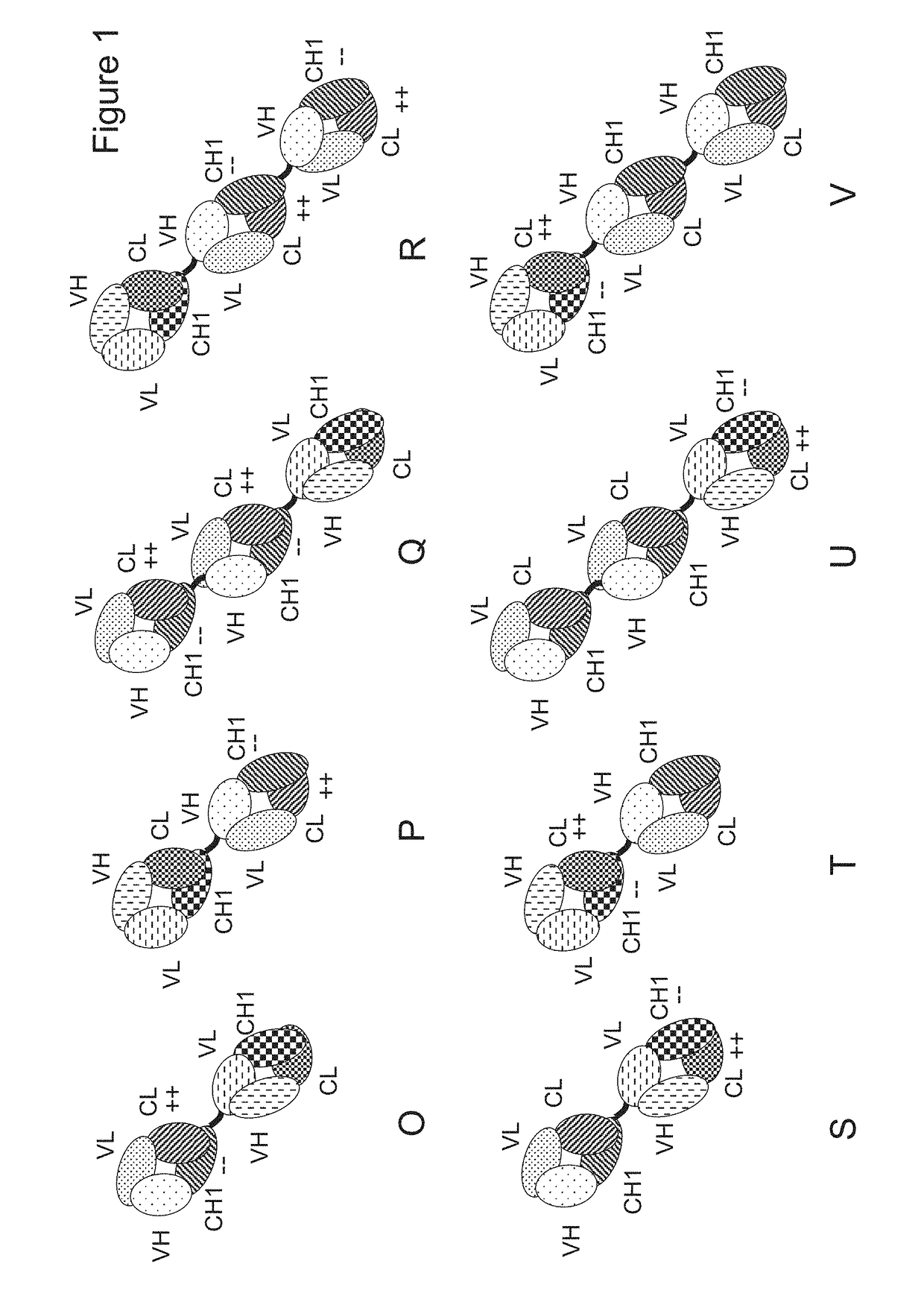Bispecific t cell activating antigen binding molecules
a technology of binding molecules and t cells, applied in the direction of immunoglobulins, peptides, drug compositions, etc., can solve the problems of igg-like formats, unable to activate the effector mechanism mediated by the fc domain, and suffer from the toxicity of the native effector functions inherent in igg molecules,
- Summary
- Abstract
- Description
- Claims
- Application Information
AI Technical Summary
Benefits of technology
Problems solved by technology
Method used
Image
Examples
example 1
Preparation of Anti-p95HER2 / Anti-CD3 T Cell Bispecific (TCB) Molecules
[0413]The following molecules were prepared in this example; schematic illustrations thereof are shown in FIG. 2:[0414]A. “2+1 IgG CrossFab, inverted” with charge modifications (VH / VL exchange in CD3 binder, charge modification in p95HER2 binder) (FIG. 2A, SEQ ID NOs 22-25).[0415]B. “2+1 IgG CrossFab, inverted” without charge modifications (CH1 / CL exchange in CD3 binder) (FIG. 2B, SEQ ID NOs 26-29).
[0416]The DNA sequences encoding the variable heavy and light chain regions of the CD3 and p95HER2 binders were subcloned in frame with the respective constant regions which are pre-inserted into the respective recipient mammalian expression vector. Protein expression is driven by an MPSV promoter. Polyadenylation is driven by a synthetic polyA signal sequence located at the 3′ end of the CDS. In addition each vector contains an EBV OriP sequence for autosomal replication.
[0417]For production of the molecules, CHO-K1 ce...
example 2
Expression Levels of p95HER2 on Different Target Cells and Binding of p95HER2 TCB to p95HER2 Positive Target Cells
[0428]The expression of p95HER2 on p95HER2 transfected MCF10A (MCF10A_p95Her2) and HCC-1954 was determined by flow cytometry using the anti-p95HER2 IgG clone 32H2 (Parra-Palau et al., Cancer Res 70, 8537-46 (2010)). The expression of p95HER2 or HER2 of different target cells (MCF10A transfected to express either p95HER2, HER2, both or an empty vector) was determined by Western Blot using an anti-HER2 antibody. The binding of p95HER2 TCB to MCF10A transfected to express either p95HER2, HER2 or both or an empty vector was tested by flow cytometry.
[0429]For Western Blot analysis, Protein extracts were obtained from lysed MCF10A transfectants. Samples were mixed with loading buffer containing DTT (250 mM Tris-HCl pH 6.8, 10% SDS, 30% glycerol, 0.5 mM 1.4-dithiothreitol DTT (Roche, #10780984001), 0.2% bromophenol blue) and incubated at 99° C. for 5 min before resolving protei...
example 3
Lysis of MCF10A Transfectants and HCC-1954 and Subsequent T Cell Activation Mediated by p95HER2 TCB
[0431]The lysis of target cells and subsequent T cell activation mediated by p95HER2 TCB was assessed using MCF10A_p95Her2, MCF10A_Her2, MCF10A_p95Her2-Her2 and MCF10A_Vector as well as HCC-1954. Human PBMCs were used as effectors and tumor lysis was detected at 46-48 h of incubation with p95HER2 TCB or an untargeted control TCB. Briefly, target cells were harvested with either StemPro Accutase or Trypsin / EDTA, washed and seeded into flat-bottom 96-well plates. Cells were left to adhere overnight. Peripheral blood mononuclear cells (PBMCs) were prepared by Histopaque density centrifugation of enriched lymphocyte preparations (buffy coats) or fresh heparinized blood obtained from healthy human donors. Fresh blood was diluted with sterile PBS and layered over Histopaque gradient or Ficoll-Paque. After centrifugation (450×g or 400×g, 30 minutes, room temperature, w / o break), the plasma ab...
PUM
| Property | Measurement | Unit |
|---|---|---|
| molecular weight | aaaaa | aaaaa |
| dissociation constant | aaaaa | aaaaa |
| dissociation constant | aaaaa | aaaaa |
Abstract
Description
Claims
Application Information
 Login to View More
Login to View More - R&D
- Intellectual Property
- Life Sciences
- Materials
- Tech Scout
- Unparalleled Data Quality
- Higher Quality Content
- 60% Fewer Hallucinations
Browse by: Latest US Patents, China's latest patents, Technical Efficacy Thesaurus, Application Domain, Technology Topic, Popular Technical Reports.
© 2025 PatSnap. All rights reserved.Legal|Privacy policy|Modern Slavery Act Transparency Statement|Sitemap|About US| Contact US: help@patsnap.com



